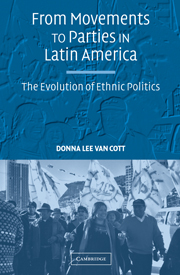Book contents
- Frontmatter
- Contents
- Preface and Acknowledgments
- Abbreviations and Acronyms
- From Movements to Parties in Latin America
- 1 Introduction: Toward a Comprehensive Theory of Ethnic Party Formation and Performance
- 2 Institutions, Party Systems, and Social Movements
- 3 “A Reflection of Our Motley Reality”: Bolivian Indians' Slow Path to Political Representation
- 4 “We Are the Government”: Pachakutik's Rapid Ascent to National Power
- 5 “It Is Not a Priority”: The Failure to Form Viable Ethnic Parties in Peru
- 6 Argentina, Colombia, and Venezuela: Unlikely Cases of Ethnic Party Formation and Success
- 7 Conclusions and Implications
- References
- Index
Preface and Acknowledgments
Published online by Cambridge University Press: 04 June 2010
- Frontmatter
- Contents
- Preface and Acknowledgments
- Abbreviations and Acronyms
- From Movements to Parties in Latin America
- 1 Introduction: Toward a Comprehensive Theory of Ethnic Party Formation and Performance
- 2 Institutions, Party Systems, and Social Movements
- 3 “A Reflection of Our Motley Reality”: Bolivian Indians' Slow Path to Political Representation
- 4 “We Are the Government”: Pachakutik's Rapid Ascent to National Power
- 5 “It Is Not a Priority”: The Failure to Form Viable Ethnic Parties in Peru
- 6 Argentina, Colombia, and Venezuela: Unlikely Cases of Ethnic Party Formation and Success
- 7 Conclusions and Implications
- References
- Index
Summary
It is a crisp, sunny, late-June day in La Paz. At 3,600 meters, the Andean sky is an implausible Soviet-postcard blue. In the Plaza de San Francisco, supporters of coca growers' leader Evo Morales are setting up for this evening's end-of-campaign rally and a few hundred supporters are congregating near the stage. As the sun begins to set, an impromptu parade winds past the Plaza, stopping rush-hour traffic on the Prado, the city's main drag. It is led by Esther Balboa, a Quechua intellectual who is the Aymara leader Felipe Quispe's vice presidential running mate in Sunday's presidential election (the scene is depicted on the jacket of this book). Less than one week before the election, Morales and Quispe, leaders of parties representing the country's indigenous majority, are expected to finish behind the pack. No one predicts the transformation that is about to occur. Quispe will merely win twice the vote of any previous indigenous presidential candidate. Morales will finish second, less than two percentage points behind the winner.
Almost exactly five years earlier, after the 1997 elections, I wrapped up doctoral dissertation research in La Paz. I had a hunch that the new indigenous peoples' parties that had formed in the 1990s might be the basis of a study of how small parties representing the marginalized indigenous population are having an impact on the quality of democracy in Latin America.
- Type
- Chapter
- Information
- From Movements to Parties in Latin AmericaThe Evolution of Ethnic Politics, pp. vii - xPublisher: Cambridge University PressPrint publication year: 2005



